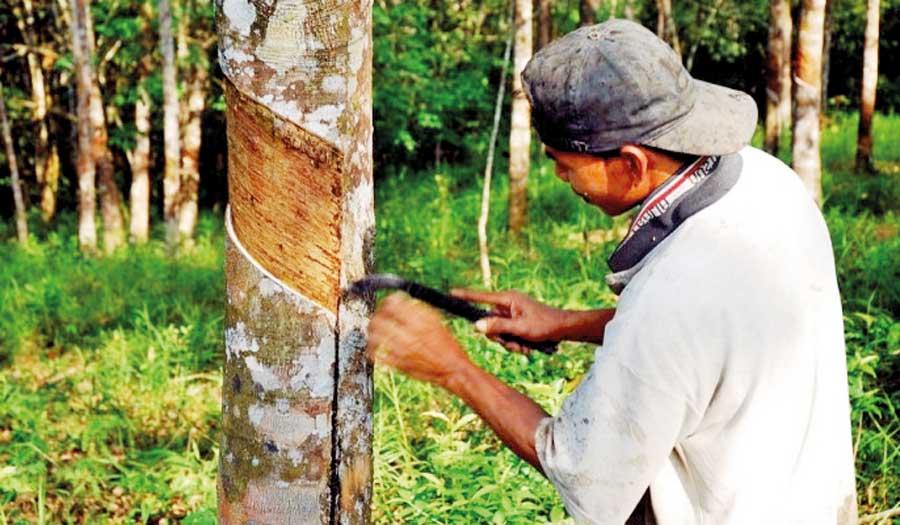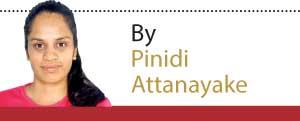26 Feb 2024 - {{hitsCtrl.values.hits}}
- The disease named Pestilotiopsis microspora is caused by two plant pathogenic fungal groups
- This disease is regarded as a secondary leaf fall condition
- The sensitivity of the disease is influenced by the nutritive status of the cultivation, age and clone
- NIPM has been empowered to issue certificates for rubber tappers, rubber nursery assistants, and rubber rain guard technicians

“Normally we used to cease tapping rubber in February, but this year we had to stop from December 2022 due to the disease spreading on the leaves of rubber trees. We have stopped collecting the harvest due to the season where leaves fall. The thickness of the rubber latex has decreased and we are not sure whether it is because of the disease,” said a rubber estate owner speaking on terms of anonymity. She also added that the government doesn’t show any urgency to get involved in these problems. This disease was first reported in 2018 in Malaysia, then in Indonesia, and later in the year 2019, Thailand, India, China and Sri Lanka experienced this fate. The situation at the time was aggravated due to the COVID-19 pandemic and later the pesticide and fertilizer banning in the country.
the disease spreading on the leaves of rubber trees. We have stopped collecting the harvest due to the season where leaves fall. The thickness of the rubber latex has decreased and we are not sure whether it is because of the disease,” said a rubber estate owner speaking on terms of anonymity. She also added that the government doesn’t show any urgency to get involved in these problems. This disease was first reported in 2018 in Malaysia, then in Indonesia, and later in the year 2019, Thailand, India, China and Sri Lanka experienced this fate. The situation at the time was aggravated due to the COVID-19 pandemic and later the pesticide and fertilizer banning in the country.
This disease is caused by two plant pathogenic fungal groups. The disease is scientifically termed as Pestilotiopsis microspora. It is observed in the entire wet zone. RRI officials state that the reason for the fungus to spread is excessive rain and the lack of sunlight. It is comparatively severe in the Ratnapura, Kalutara, Awissawella and Daraniyagala areas. Moderate to mild levels of the disease are seen in Galle, Matara, Badulla and Monaragala. Low canopy weak plants – which are called ‘runts’ – contract the disease at the early stages and spread it to the surrounding plants. Warm and humid conditions favour the spread of the disease and also the development of the trees as they need an optimal temperature ranging from 25ºC – 30ºC, and a relative humidity which must be above 80%. This disease is regarded as a secondary leaf fall condition.
One should have 3 years of experience to apply for NVQ-03 level certificates. The Level-04 certificate will be provided only to individuals who have 5 years of experience in the supervisory grade. NVQ-Level-05 is the Diploma whilst Level-06 is the Higher National Diploma (HND), and Level-07 is the Degree level
“Extension Officers reported the disease from the Kalutara district by August 2019. The production of rubber is declining not from 2019, but from 2014 onwards. The disease is not only spreading in Sri Lanka, but in all Asian rubber-growing countries as well. The disease is just one reason for the reducing of the crop,” said Dr. Sarojini Fernando, Department head of Plant Pathology and MicroBiology at Rubber Research Institute (RRI). She clarified that the fall of leaves isn’t happening due to the disease, but it is a natural phenomenon that happens annually. This disease is common and is reported in all Asian rubber plants. To date, the death of trees hasn’t been reported from any part of the world. Different countries are attempting to find a cure for this disease, but still, there is no chemical controlling method introduced. Circular lesions on the leaves are initially small and dark brown and later expanding to form larger spots with dark brown margins and yellow halos. The nature of the spreading of the disease depends on different locations. The sensitivity of the disease is influenced by the nutritive status of the cultivation, age and clone.
However, there is only a 10 percent decrease in the crop. She said that the whole country has lost around 10% of the crop. “50% of rubber is supplied from the local rubber estates. Therefore, there is a need to improve the productivity of the rubber cultivation to sustain this industry,” said Dr. Fernando. If the dry rubber content is below 30%, the tapping would be temporarily stopped and the Rubber Development Department (RDD) or RRI should be informed. The individual who spoke on terms of anonymity said that the government only played a minor part in terms of taking responsibility for controlling the spread of the disease. “No compensation is paid to the rubber estate owners, but they were constantly being advised and provided with the necessary machinery and fertilizer until very recently to keep the disease under control,” said Dr. Fernando. Three rounds of fungicide sprays should be sprayed, according to agriculture experts: The First round – at the stage of apple green leaves: Second round – At the stage of semi-mature to mature stage: Third round – After full maturation. The first round can be undertaken around July and August and the second, during September and October.
The production of rubber is declining not from 2019, but from 2014 onwards. The disease is not only spreading in Sri Lanka, but in all Asian rubber-growing countries as well. The disease is just one reason for the reduction in crop
-Dr. Sarojini Fernando, Department Head of Plant Pathology and Microbiology at the Rubber Research Institute (RRI)
Dr. Fernando added that the amount of latex has decreased not due to the disease, but to the shedding of the leaves of the rubber plants. From December to January well-grown, matured rubber plants are shedding their leaves. It takes two to three weeks for the plants to grow new leaves. The disease is not found in the new leaves. She said that after about three months the disease will appear on the leaves of the plants again. The most important strategy is the maintenance of clonal balance. At present the existence of a single clone in the country has exposed the country’s crop to highrisk. However, integrated disease management approaches in cooperating cultural, chemical and biological strategies are explored to optimise disease control while minimising environmental impacts and production costs.
Dr. Fernando proposed several measures that can be implemented to control the disease such as applying fertilizer and improving sanitation. But due to the high cost of fertilizer, users are reluctant to apply it on trees. Plants become weak due to improper fertilization, and as a result they contract the disease very quickly.
The NIPM keeps in contact with the Estate owners. NIPM keeps contact with smallholders, large-scale companies and regional plantation companies in the corporate sector. Tappers are allowed to work on any estate after receiving the certificate
- Dr. Prasad Dharmasena, Director/Chief Executive Officer of the (NIPM) Ministry of Plantation Industries
There are methods that could keep this disease under control. Dr. Fernando advised estate owners to apply fungicides and adhere to correct agronomic practices such as fertilization and keeping the right sapping protocol (people should tap once in two days but people are doing it regularly) to avoid extra pressure on the plant. She said that people have been advised to collect the fallen dead leaves into a drench and accelerate composting. The Rubber Research Institute has implemented a process to collect the diseased leaves. “People might not be able to do everything, but still, they could try to carry out remedies from a broader perspective to manage the disease,” said Dr. Fernando. The disease may adversely impact the status of the plantation if not properly maintained.
Dr. Fernando makes the rubber estate owners aware that if they are losing more than 10% in their cultivation, they should inform the Call Centre of the Rubber Research Institute or the Rubber Development Department for help from.
She also explained that the Rubber Research Institute will always help them with their research to solve any discipline that belongs to rubber cultivation. The Rubber Development Department must disseminate all the details and information regarding rubber cultivation. Officials from the Department will be visiting the estates and providing owners with necessary information to prevent the destruction of the cultivation.
An NVQ-3 certificate is introduced to the rubber tappers to improve their skills related to the rubber industry.
“We are not sure whether our tappers will move to another estate after obtaining the certificate under our guidance,” said a rubber estate owner who also didn’t wish to be named.
“NIPM has been empowered to issue certificates for rubber tappers, rubber nursery assistants, and rubber rain guard technicians,” said Director Chief Executive Officer of the (NIPM) Ministry of Plantation Industries, Dr. Prasad Dharmasena. “A Rubber Nursery assistant certificate is issued for specialising in handling a rubber nursery. The rain guard technique is used during the rainy season for tapping. A special technique and knowledge are used for fixing the rain guard,” said Dr. Dharmasena.
Three rounds of fungicide sprays should be sprayed, according to agriculture experts: The First round – at the stage of apple green leaves: Second round – At the stage of semi-mature to mature stage: Third round – After full maturation. The first round can be undertaken around July and August and the second, during September and October
The National Institute of Plantation Management (NIPM) is registered under the Ministry of Agriculture and Plantation Industries. All certificates are registered under the Territory and Vocational Education Commission (TVEC). Since the NIPM is registered under the TVEC, the NIPM is assigned with the power to issue certificates. The TVEC has decentralised its powers to NIPM.
Dr. Dharmasena explained two ways to obtain a qualification in the rubber sector. Under the method of Recognition of Prior Learning (RPL), one should have 3 years of experience to apply for NVQ-03 level certificates. The RPL-Level-04 certificate will be provided only to individuals who have 5 years of experience in the supervisory grade. He added that to apply for an RPL certificate the candidate should visit the institute (NIPM) and appear for the assessment to obtain the certificate. After the evaluation is done, within a week the certificate will be issued. He also added that NVQ-Level-03 and NVQ-Level-04 candidates are given both theoretical and practical knowledge; the six months training comprising three months practical knowledge and three months theoretical knowledge. NIPM awards 26 different types of occupations issued through RPL certificates. Moreover, he explained that NVQ-03 and NVQ-04 certificate courses are focused on occupation. NVQ-Level-05 is the Diploma whilst Level-06 is the Higher National Diploma (HND), and Level -07 is the Degree level.
“NIPM keeps in contact with the Estate owners. NIPM keeps contact with smallholders, large-scale companies and regional plantation companies in the corporate sector. Tappers are allowed to work on any estate after receiving the certificate,” said Dr. Dharmasena. He confirmed that RPL and NVQ certificates are internationally recognised. The aim of issuing this certificate is to enhance the competency of industrialization and provide recognition for the rubber tappers by enhancing their knowledge and competency,” said Dr. Dharmasena.
The NIPM allows rubber tappers to develop their knowledge in the rubber industry as well as to be aware of the different types of diseases caused in Rubber plants.
01 Jan 2025 1 hours ago
01 Jan 2025 2 hours ago
01 Jan 2025 2 hours ago
01 Jan 2025 3 hours ago
01 Jan 2025 4 hours ago